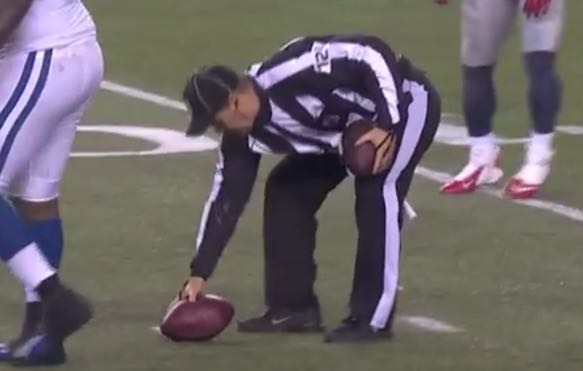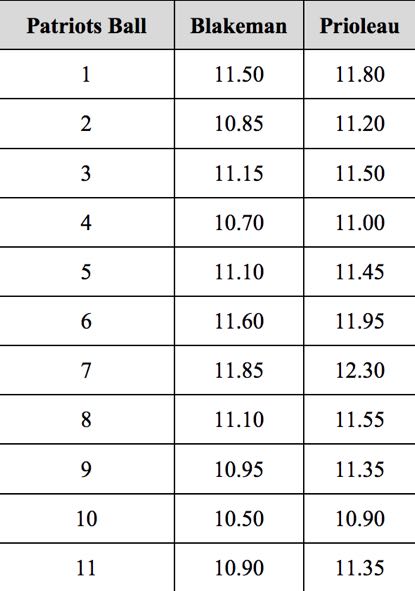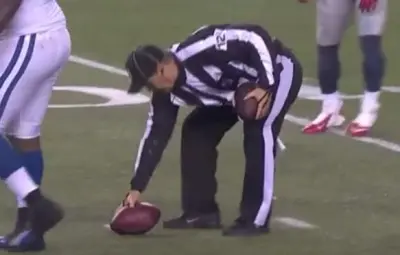
Before I get accused (yet again) of being a New England Patriots apologist, go ahead and do some digging into the actual meat of the Ted Wells report. What you might find is that the role veteran NFL referee Walt Anderson played in the Deflategate investigation is, at best, rather ambiguous.
For starters, it seems to make absolutely no sense that Anderson didn’t log the exact air pressure of each football before the game if he knew the NFL had been tipped off about the Patriots allegedly tampering with balls. The only thing Anderson knows for sure — or so he says — is that both team’s balls were within the allowable limit of 12.5-13.5 PSI.
Here’s where it gets interesting. At halftime of the AFC Championship Game, two different gauges were used to measure 11 of New England’s game balls and four from the Colts. The Patriots’ balls measured as follows:

As Mike Florio of Pro Football Talk noted over the weekend, the Wells report explains that one gauge had a Wilson logo on the back of it and a long, crooked needle. The other gauge had no logo and a short, straight needle. While he was not 100 percent certain, Anderson said that his “best recollection” is that he used the gauge with the Wilson logo, which is the one that consistently generated higher measurements.
Somehow, the investigation team used by Wells conveniently came to the conclusion that Anderson “misremembered” which gauge he used. While we’re willing to trust that Anderson actually did his job and measured the balls properly, we’re apparently not willing to trust that he remembers using a gauge with a logo on it and a crooked needle — the gauge that gave higher PSI readings.
If Anderson did, in fact, use the gauge he thought he used, the Ideal Gas Law would predict that the Patriots’ balls should have measured between 11.52 and 11.32 PSI at halftime if they were inflated to 12.5 PSI — the lower end of the legal limit — before the game. And, wouldn’t you know, eight of New England’s 11 balls fell within the range that the Wells report concluded could have been explained by the Ideal Gas Law.
But, again, Wells and company determined that Anderson actually used the gauge that provided lower readings even though his “best recollection” was that he used the other one.
Remember that early report about the Patriots’ balls being 2.0 PSI underinflated at halftime? Even if you use the gauge that provided lower readings (the one Anderson thought he didn’t use before the game), that was only true of one ball. And it was only true of one ball after the Ideal Gas Law would have come into play.
All that said, the text messages that were exchanged between Patriots equipment managers Jim McNally and John Jastremski (read them here) don’t look good for Tom Brady and the Pats. But, even with those, a few interesting details have largely been ignored. For example, Jastremski told McNally that the officials had inflated some of the game balls to 16 PSI.
“I checked some of the balls this morn … The refs f—ed us … a few of then were at almost 16,” Jastremski wrote to McNally. “They didnt recheck then after they put air in them.”
Keep in mind that Jastremski said he checked the balls in the morning, so he wasn’t referring to right before kickoff when the officials test the balls one last time. NFL teams are in control of their game balls leading up to games before turning them in for final inspection.
Is it possible — even if not “more probable than not” — that Jastremski and McNally were complaining about how particular Brady is about the game balls in the days leading up to games? Does that necessarily prove that someone stuck a needle in a ball just before the AFC Championship Game, especially with all the glaring holes in the Wells report?
Of course, the NFL does not have to follow the same guidelines as a court of law. Roger Goodell can decide that the text messages are enough and that Brady’s refusal to turn over his cell phone was the icing on the cake, but the fact that so many are ignoring Anderson’s recollection is a good example of the confirmation bias hard at work.


